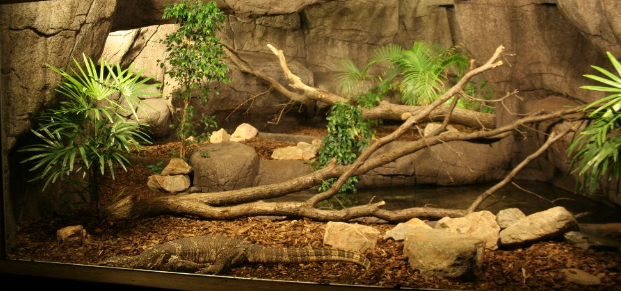Australia’s diverse climate presents unique challenges and opportunities for reptile owners when deciding between indoor and outdoor enclosures. Each option offers its own advantages, but both must be carefully tailored to ensure your reptile’s health and well-being. This guide explores the benefits and challenges of both types of enclosures, emphasizing best practices for maintaining them in Australia’s varied climates.
1. Indoor Reptile Enclosures

Benefits:
- Controlled Climate: Indoors, you can control temperature, humidity, and lighting with precision. For reptiles in regions with extreme temperatures, such as the scorching summers of northern Australia or the cold winters of Tasmania, indoor enclosures ensure stable conditions year-round. Species like blue-tongue lizards and central bearded dragons thrive in stable environments where temperature gradients are carefully controlled.
- Predator Protection: Indoors, your reptile is safe from predators like birds, cats, and even venomous spiders, which is crucial for smaller or vulnerable species such as geckos or juvenile snakes. In outdoor settings, even well-secured enclosures can sometimes be penetrated by opportunistic predators, making indoor housing a safer alternative for reptiles not suited to outdoor environments.
- Prevention of Escape: An indoor setting minimizes the risk of escape. In Australia, where some reptiles are regulated, an escaped reptile could lead to legal complications or endanger local wildlife. Species like pythons or carpet snakes, if lost, can become invasive in local ecosystems, disrupting the natural balance.
Challenges:
- Limited Space: Indoor enclosures are often smaller than outdoor ones, which may limit how much space larger species like monitor lizards or carpet pythons have to move around. Large reptiles need ample space to express natural behaviors such as climbing, digging, or basking, which can be difficult to provide indoors.
- Artificial Environment: While indoor environments can mimic natural sunlight with UVB lighting, they still lack the full benefits of direct sunlight. This artificial environment may not always perfectly replicate a reptile’s natural habitat, potentially impacting long-term health, particularly in species that rely heavily on natural UVB exposure for calcium metabolism, such as bearded dragons and blue-tongue lizards.
- Cost: Maintaining temperature, lighting, and humidity indoors can drive up electricity costs, particularly in areas where climate control is needed year-round. Heat lamps, ceramic heaters, and UVB bulbs can become expensive, especially in regions where temperatures fluctuate widely, requiring more energy to maintain the correct environment.
Species Considerations for Indoor Enclosures
- Bearded Dragons: Require basking temperatures of 35-40°C, so a heating lamp is essential for indoor setups. A temperature gradient should be maintained within the enclosure, and UVB lighting must be on for at least 10-12 hours a day to promote proper bone growth.
- Blue-Tongue Lizards: These reptiles prefer a cooler gradient with basking temperatures of around 32°C. UVB light is necessary for proper calcium metabolism indoors. Without proper UVB exposure, blue-tongue lizards may develop metabolic bone disease.
2. Outdoor Reptile Enclosures
Benefits:
- Natural Sunlight: Outdoor enclosures give reptiles access to natural UVB rays, which are essential for species like bearded dragons, frill-necked lizards, and blue-tongue lizards. Natural sunlight promotes better health and reduces reliance on artificial lighting. For many reptiles, direct exposure to sunlight can help regulate circadian rhythms and improve overall vitality.
- Spacious Environment: Outdoor enclosures allow for larger, more complex habitats. This is particularly beneficial for active reptiles like frill-necked lizards, centralian pythons, and water dragons, which need space to roam, climb, and bask. Outdoor enclosures can be designed to mimic natural habitats more closely, allowing reptiles to express natural behaviors such as burrowing or climbing.
- Cost Efficiency: Outdoor setups reduce the need for continuous artificial heating and lighting, making them more cost-efficient in regions with milder climates. In parts of Australia with temperate weather, natural sunlight and temperature regulation can minimize reliance on expensive heating systems.
Challenges:
- Weather Extremes: Australia’s climate ranges from tropical in Queensland to arid in the Outback, which can expose reptiles to dangerous temperature fluctuations. In hot areas, overheating is a significant concern, while colder regions may require supplementary heating during winter. Outdoor enclosures must be designed with the local climate in mind, and owners must monitor temperature changes to prevent heatstroke or hypothermia in their reptiles.
- Predator and Security Risks: Outdoor enclosures must be secure to protect reptiles from predators like birds of prey, snakes, and feral cats. A well-secured enclosure with sturdy mesh and locks is essential for safety. In rural or suburban areas, native predators, such as kookaburras or large monitor lizards, could pose a threat to small reptiles if the enclosure isn’t predator-proof.
- Parasites and Disease: Outdoor setups expose reptiles to natural elements, increasing the risk of parasites or diseases from local wildlife or plants. Regular monitoring and health checks are crucial for reptiles housed outdoors. Owners should also be cautious of introducing wild-caught insects into the enclosure as they may carry harmful pathogens.
DIY Outdoor Enclosure Design
Building an outdoor enclosure requires careful planning:
- Materials: Use untreated wood for framing to prevent harmful chemicals from affecting your reptile. Sturdy mesh is necessary for ventilation, and consider predator-proofing with locked gates and mesh tops. For regions prone to high winds or rain, reinforce the enclosure structure with weatherproof materials like stainless steel or aluminum frames.
- Temperature and Shade: Provide plenty of shaded areas to prevent overheating, and consider adding ceramic heaters or heat lamps during cooler seasons. You can also use retractable shades or place the enclosure in a naturally shaded part of your yard to regulate heat exposure.
- Waterproof Shelters: Ensure there are waterproof areas where reptiles can escape rain and wind. In areas prone to heavy rainfall or extreme weather events, such as cyclones in Queensland, waterproofing is essential to prevent enclosures from flooding.
3. Adapting Enclosures to Australia’s Climate

Indoor Climate Control
- Use thermostats and timers to maintain consistent heating and lighting schedules. For reptiles like centralian pythons, ensure basking areas reach the required temperatures (around 30-32°C), with cool zones in the mid-20s°C. Humidity levels should also be controlled, particularly for species that require more arid environments, such as spiny-tailed skinks.
Outdoor Adaptations
- Northern Australia: Enclosures must be designed with extreme heat in mind. Add plenty of ventilation and natural shade, and ensure the reptile has access to cool areas during the day. In regions where temperatures exceed 40°C, misting systems or automated sprinklers may help keep reptiles cool.
- Southern Australia: For colder regions, supplemental heating is necessary. Use ceramic heat emitters or under-enclosure heating pads to maintain temperatures during cooler months. Outdoor enclosures may also need to be insulated to retain heat overnight, especially for species like children’s pythons, which are sensitive to cold.
- Rain and Wind Protection: Use durable, waterproof materials for shelters, particularly in regions prone to rainstorms, such as coastal Queensland. Strong winds can damage outdoor enclosures, so structures should be anchored securely to withstand high winds.
Seasonal Adjustments
- Seasonal Relocation: Consider moving reptiles indoors during extreme temperatures (winter in Tasmania, summer in the Northern Territory) to ensure they are not exposed to dangerous heat or cold. Seasonal shifts in temperature and daylight should be anticipated and managed, with indoor setups providing a safe alternative during extreme weather.
4. Safety and Enrichment for Both Enclosures
- Security: Outdoor enclosures must have secure locks and sturdy mesh to prevent predators from entering and reptiles from escaping. Double-check locks regularly and ensure that small reptiles cannot slip through the mesh or any openings.
- Ventilation and Hygiene: Both indoor and outdoor enclosures require proper ventilation to prevent the buildup of harmful bacteria. Clean regularly, and for outdoor setups, ensure the substrate is well-drained to avoid the spread of parasites. Replace any soiled substrate immediately, particularly in outdoor enclosures where humidity may promote bacterial growth.
- Enrichment: Include natural elements like rocks, branches, and logs to mimic the reptile’s natural environment. These elements promote healthy behaviors like climbing, basking, and burrowing. For indoor setups, consider using artificial plants and rocks to simulate the natural environment without introducing the risks associated with live plants.
Conclusion
Deciding between an indoor or outdoor reptile enclosure in Australia requires a careful balance between climate control, security, and your reptile’s specific needs. Indoor enclosures offer climate stability and predator protection, while outdoor enclosures provide natural sunlight and more space. Understanding the Australian climate and adapting your enclosure to suit both the environment and your reptile’s species is key to ensuring a healthy, safe, and enriching home for your pet.
